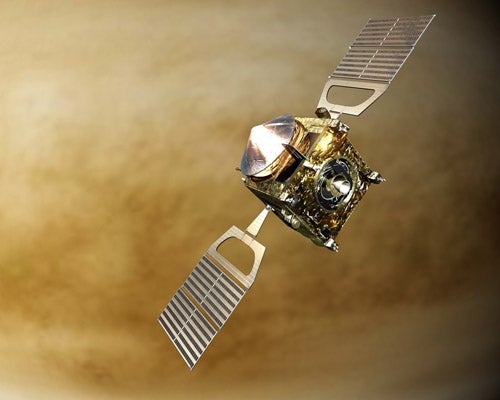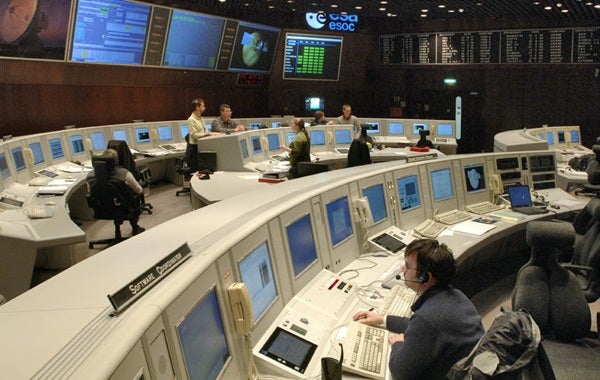Earlier today, the European Space Agency’s (ESA) Venus Express fired its engine and settled into orbit around Venus. The 50-minute maneuver, which began at 3:17 a.m. EDT, slowed the spacecraft’s 18,000 mph (29,000 km/h) velocity relative to Venus by about 15 percent — enough for Venus’ gravity to capture the probe into orbit. This critical maneuver is the mission’s last high-risk hurdle.
“It’s a fantastic mission for us,” says project manager Don McCoy. “We’ve finally reached Venus.” The first image of Venus’ south pole could arrive as early as Thursday.
Venus Express ends a long hiatus in planetary exploration. It’s the first probe dedicated to studying our neighbor planet since NASA’s radar-mapping Magellan mission’s fatal 1994 plunge into Venus’ atmosphere.
ESA ground controllers will adjust the probe’s orbit through May 6. Eventually, Venus Express will loop around the planet’s poles at altitudes ranging from 155 miles (250 km) to 41,000 miles (66,000 km). Once Venus Express achieves this orbit, ESA scientists will spend the rest of the month testing the craft’s instruments. The orbiter’s primary science mission is expected to begin June 4 and continue for at least two venusian days, or 486 Earth days.
Venus Express follows ESA’s successful Mars Express mission, which reached the Red Planet in 2003. “We’ve put together a second planetary mission in as short a time as possible,” McCoy says. “We’ve put two satellites around two planets. It’s incredible what we’ve accomplished.”
The spacecraft’s Venus Mapping Camera will be the first to study the planet at wavelengths across the spectrum, from the infrared to the ultraviolet. It will even be able to look for persistent hot spots on the surface possibly caused by volcanic eruptions in progress. Although the Venus Mapping Camera was developed for Venus Express, most of the instruments were built from flight-qualified spares for two ESA missions already flown — Mars Express and Rosetta.
Venus is shrouded by a thick mantle of perpetual clouds made of sulfuric acid, not water. The planet’s dense carbon-dioxide atmosphere creates a surface pressure equivalent to that found thousands of feet below the surface of Earth’s oceans. And while spacecraft have landed on the surface — notably the Russian Venera probes of the 1970s and 1980s — none of them survived long.
Venus has no oceans, lakes, rivers, or rainfall. The planet’s high surface temperature — a constant 870º Fahrenheit (465º Celsius), hotter than an oven’s broiler — prevents any liquid water. A thick carbon-dioxide atmosphere insulates the planet, which reduces its ability to radiate heat into space, so the surface temperature rises. Call it global warming gone wild.
Yet scientists think Venus may once have held oceans, just like Earth, and they’d like to understand why the two worlds are so dissimilar now.
Mission planners expect Venus Express’ mapping mission to last 500 Earth days. But the spacecraft carries enough fuel to maintain its polar orbit twice this long. Venus Express launched from Kazakhstan’s Baikonur Cosmodrome on a Russian Soyuz-Fregat rocket November 9 and cruised through space for 153 days.











